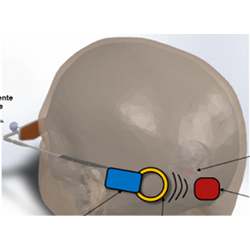
French researchers are developing a video technology that will completely bypass the eyes and project an image directly into one's brain.
Essentially, they want to enable the blind to see again, without ever having to rely on the human eye.
The researchers have been partially successful in their quest; so far, they have found a way to model how the human retina captures visual information using machine vision, a camera, and a computer.
"We aim at extending this modeling to the visual cortex" of the brain, says Serge Picaud, scientific supervisor at Institut de la Vision in Paris, France, who is working with Jose Alain Sahel, the Institute's director, to return sight to those who live in darkness.
Both Picaud and Sahel are part of a larger, $21.6-million initiative squired by the U.S. Defense Advanced Research Projects Agency (DARPA), which is looking to use technology to enable the blind to see, the deaf to hear, and the speech-impaired to talk.
"We in the field have had success with retinal prostheses both here in the U.S. and Europe to restore some vision to the blind," says John Dowling, a professor emeritus at Harvard University, commenting on the work of Picaud, Sahel, and other researchers engaged in similar work.
Picaud and Sahel hope their nascent technology will ultimately work by using a specially designed machine vision camera from Chronocam, which will feed imagery from the outside world into a pocket computer. Once processed, the visual signal will be broadcast to wireless devices the researchers plan to implant inside the brain, which in turn will fire individual neurons in the brain's visual cortex to create sight.
"The implanted devices containing LED arrays will deliver light stimuli on the visual cortex," Sahel says.
One of the most intriguing aspects of Picaud and Sahel's work is how they plan to get the individual neurons inside the brain to translate a visual signal from a pocket PC into information the brain can use to create sight. Their solution: injecting the genetic code of microbial opsin—or light-sensitive proteins—into one million neurons in the brain.
Each injection of microbial opsin, Picaud says, transforms "any neuron into a photo-receptor."
With a million neurons transformed into photo-receptors, getting a person to see again (at least in theory, at this point) is simply a matter of sending the correct visual information to the correct neuron for processing; similar, in a sense, to how a computer sends the correct visual information to each of the 1.3-million pixels that make up a 1280 x 1024 PC monitor to create a screen image.
As Picaud and Sachel perfect their approach—they'll be experimenting on animals before they move into the human brain—other researchers enlisted for the DARPA project will be working on other ways to enable the blind to see.
A John B. Pierce Laboratory team led by Vincent Pieribone, for example, is pursuing an interface system similar to Picaud's and Sachel's, in which modified neurons capable of bioluminescence would enable the brain to create an image transmitted from the outside world.
Meanwhile, a team led by Ehud Isacoff at the University of California, Berkeley, is working to develop a light field holographic microscope that would send a visual signal to up to a million neurons in the cerebral cortex.
At Paradromics, in San Jose, CA, CEO Matthew Angle and his team are looking to create a device that will serve as a cortical interface between the outside world and the brain. The future technology would use large arrays of micro-wire electrodes for high-resolution recording and stimulation of neurons.
Columbia University also has a team on the project, led by Lau Family professor of electrical engineering and professor of Biomedical Engineering Ken Shepard. The Columbia team envisions developing a device that would be surgically implanted in the brain to bring in imagery from the outside world.
"We are developing a wireless, flexible CMOS chip that is implanted onto the surface of the brain," Shephard says. "It communicates wirelessly with a battery-powered 'relay station,' which resides just outside the skull."
Says Phillip Alvelda, manager of DARPA's Neural Engineering System Design (NESD) program, "By increasing the capacity of advanced neural interfaces to engage more than one million neurons in parallel, NESD aims to enable rich, two-way communication with the brain at a scale that will help deepen our understanding of that organ's underlying biology, complexity, and function."
"Its deeper complexities are going to remain a mystery for some time to come," Alvelda adds, "but if we're successful in delivering rich sensory signals directly to the brain, NESD will lay a broad foundation for new neurological therapies."
Joe Dysart is an Internet speaker and business consultant based in Manhattan.



Join the Discussion (0)
Become a Member or Sign In to Post a Comment